Business Economics - Effects of Quantitative Easing on Global Economy
VerifiedAdded on 2020/05/28
|12
|2997
|189
Essay
AI Summary
This essay provides a detailed analysis of quantitative easing (QE), an expansionary monetary policy implemented by central banks worldwide to stimulate economic growth, particularly during times of financial crisis and stagnation. The essay begins by defining QE and explaining its operational mechanisms, including lowering market interest rates and increasing the money supply through the purchase of securities. It then examines the historical implementation of QE, starting with Japan and extending to the United States, the United Kingdom, and the Eurozone, especially in response to the 2007-2008 global financial crisis. The essay highlights the benefits of QE, such as lower interest rates, increased borrowing and investment, and reduced unemployment, supported by empirical evidence from the US economy. However, it also critically evaluates the drawbacks, including the potential for asset bubbles, particularly in the housing market, and the associated risks of wealth transfer and market crashes. The essay uses figures and data to illustrate the impacts of QE on GDP and unemployment rates. Finally, it concludes by summarizing the mixed effects of QE, acknowledging its effectiveness in crisis management while cautioning about its potential long-term negative consequences.
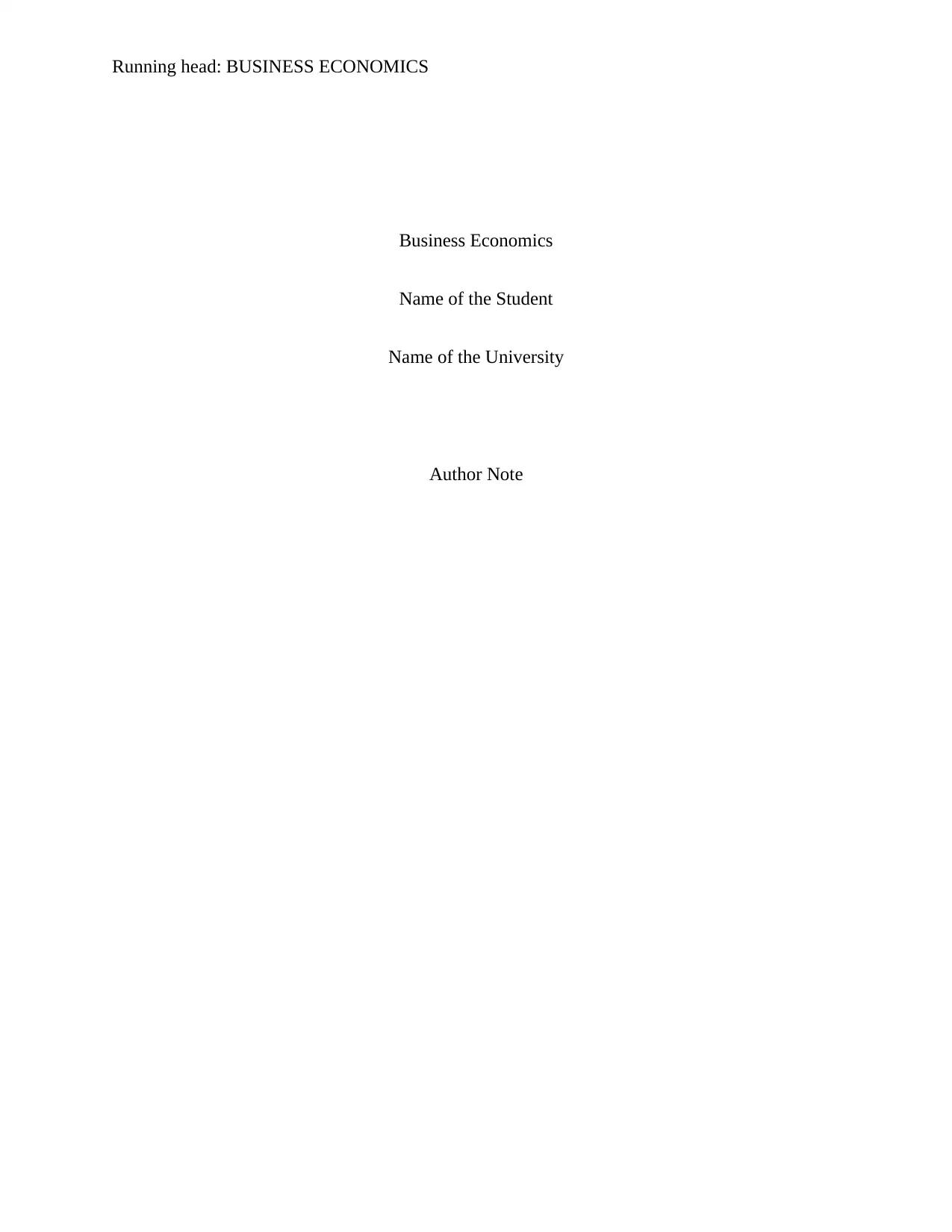
Running head: BUSINESS ECONOMICS
Business Economics
Name of the Student
Name of the University
Author Note
Business Economics
Name of the Student
Name of the University
Author Note
Paraphrase This Document
Need a fresh take? Get an instant paraphrase of this document with our AI Paraphraser
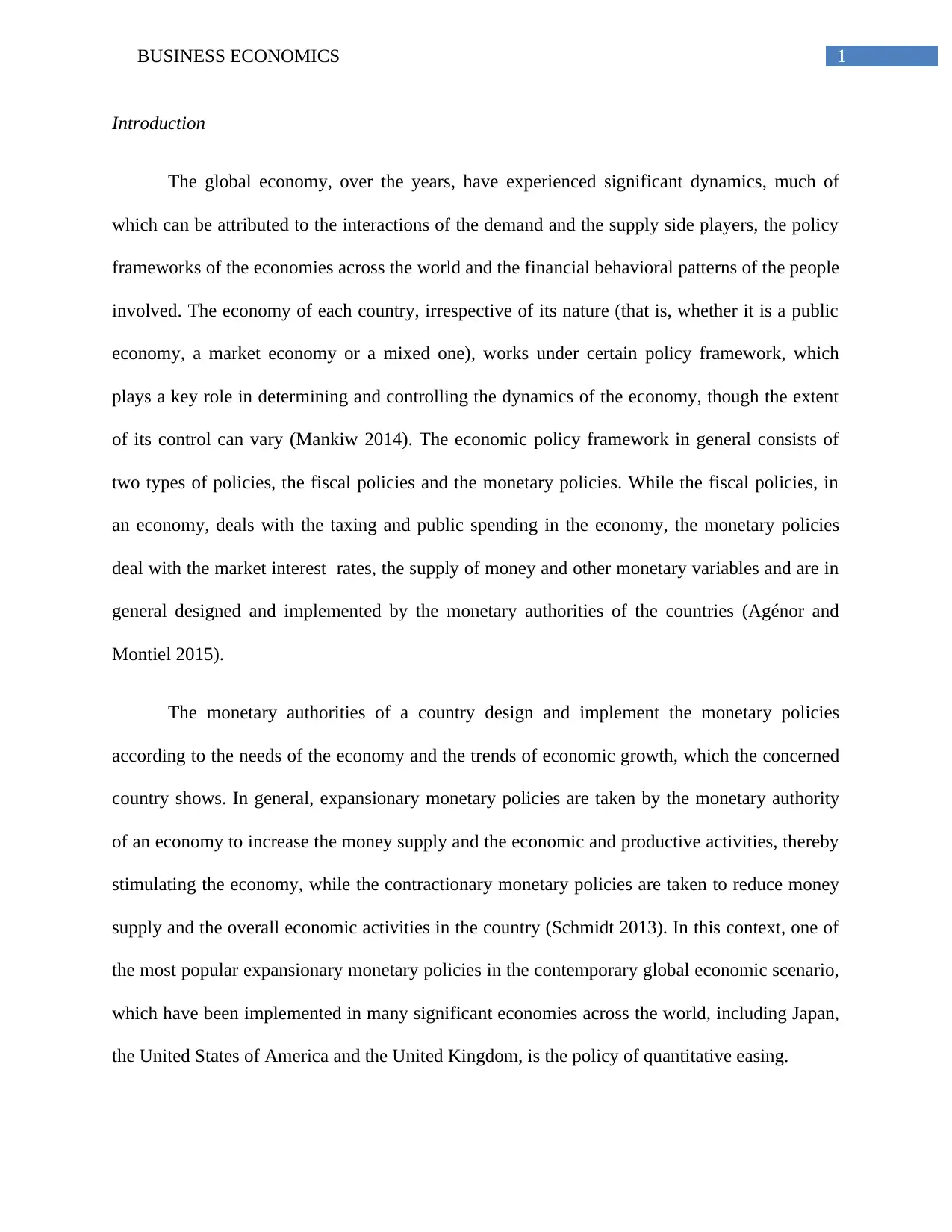
1BUSINESS ECONOMICS
Introduction
The global economy, over the years, have experienced significant dynamics, much of
which can be attributed to the interactions of the demand and the supply side players, the policy
frameworks of the economies across the world and the financial behavioral patterns of the people
involved. The economy of each country, irrespective of its nature (that is, whether it is a public
economy, a market economy or a mixed one), works under certain policy framework, which
plays a key role in determining and controlling the dynamics of the economy, though the extent
of its control can vary (Mankiw 2014). The economic policy framework in general consists of
two types of policies, the fiscal policies and the monetary policies. While the fiscal policies, in
an economy, deals with the taxing and public spending in the economy, the monetary policies
deal with the market interest rates, the supply of money and other monetary variables and are in
general designed and implemented by the monetary authorities of the countries (Agénor and
Montiel 2015).
The monetary authorities of a country design and implement the monetary policies
according to the needs of the economy and the trends of economic growth, which the concerned
country shows. In general, expansionary monetary policies are taken by the monetary authority
of an economy to increase the money supply and the economic and productive activities, thereby
stimulating the economy, while the contractionary monetary policies are taken to reduce money
supply and the overall economic activities in the country (Schmidt 2013). In this context, one of
the most popular expansionary monetary policies in the contemporary global economic scenario,
which have been implemented in many significant economies across the world, including Japan,
the United States of America and the United Kingdom, is the policy of quantitative easing.
Introduction
The global economy, over the years, have experienced significant dynamics, much of
which can be attributed to the interactions of the demand and the supply side players, the policy
frameworks of the economies across the world and the financial behavioral patterns of the people
involved. The economy of each country, irrespective of its nature (that is, whether it is a public
economy, a market economy or a mixed one), works under certain policy framework, which
plays a key role in determining and controlling the dynamics of the economy, though the extent
of its control can vary (Mankiw 2014). The economic policy framework in general consists of
two types of policies, the fiscal policies and the monetary policies. While the fiscal policies, in
an economy, deals with the taxing and public spending in the economy, the monetary policies
deal with the market interest rates, the supply of money and other monetary variables and are in
general designed and implemented by the monetary authorities of the countries (Agénor and
Montiel 2015).
The monetary authorities of a country design and implement the monetary policies
according to the needs of the economy and the trends of economic growth, which the concerned
country shows. In general, expansionary monetary policies are taken by the monetary authority
of an economy to increase the money supply and the economic and productive activities, thereby
stimulating the economy, while the contractionary monetary policies are taken to reduce money
supply and the overall economic activities in the country (Schmidt 2013). In this context, one of
the most popular expansionary monetary policies in the contemporary global economic scenario,
which have been implemented in many significant economies across the world, including Japan,
the United States of America and the United Kingdom, is the policy of quantitative easing.
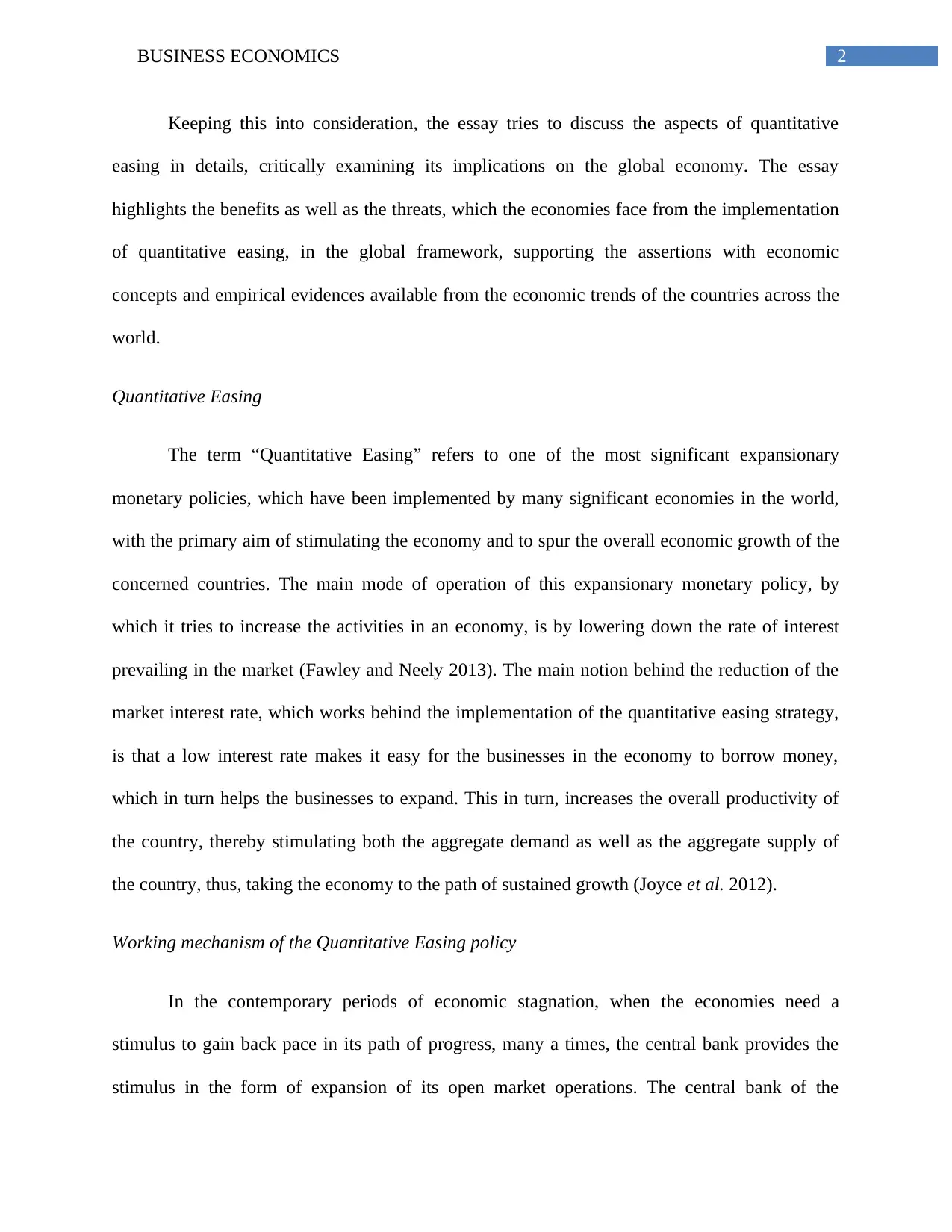
2BUSINESS ECONOMICS
Keeping this into consideration, the essay tries to discuss the aspects of quantitative
easing in details, critically examining its implications on the global economy. The essay
highlights the benefits as well as the threats, which the economies face from the implementation
of quantitative easing, in the global framework, supporting the assertions with economic
concepts and empirical evidences available from the economic trends of the countries across the
world.
Quantitative Easing
The term “Quantitative Easing” refers to one of the most significant expansionary
monetary policies, which have been implemented by many significant economies in the world,
with the primary aim of stimulating the economy and to spur the overall economic growth of the
concerned countries. The main mode of operation of this expansionary monetary policy, by
which it tries to increase the activities in an economy, is by lowering down the rate of interest
prevailing in the market (Fawley and Neely 2013). The main notion behind the reduction of the
market interest rate, which works behind the implementation of the quantitative easing strategy,
is that a low interest rate makes it easy for the businesses in the economy to borrow money,
which in turn helps the businesses to expand. This in turn, increases the overall productivity of
the country, thereby stimulating both the aggregate demand as well as the aggregate supply of
the country, thus, taking the economy to the path of sustained growth (Joyce et al. 2012).
Working mechanism of the Quantitative Easing policy
In the contemporary periods of economic stagnation, when the economies need a
stimulus to gain back pace in its path of progress, many a times, the central bank provides the
stimulus in the form of expansion of its open market operations. The central bank of the
Keeping this into consideration, the essay tries to discuss the aspects of quantitative
easing in details, critically examining its implications on the global economy. The essay
highlights the benefits as well as the threats, which the economies face from the implementation
of quantitative easing, in the global framework, supporting the assertions with economic
concepts and empirical evidences available from the economic trends of the countries across the
world.
Quantitative Easing
The term “Quantitative Easing” refers to one of the most significant expansionary
monetary policies, which have been implemented by many significant economies in the world,
with the primary aim of stimulating the economy and to spur the overall economic growth of the
concerned countries. The main mode of operation of this expansionary monetary policy, by
which it tries to increase the activities in an economy, is by lowering down the rate of interest
prevailing in the market (Fawley and Neely 2013). The main notion behind the reduction of the
market interest rate, which works behind the implementation of the quantitative easing strategy,
is that a low interest rate makes it easy for the businesses in the economy to borrow money,
which in turn helps the businesses to expand. This in turn, increases the overall productivity of
the country, thereby stimulating both the aggregate demand as well as the aggregate supply of
the country, thus, taking the economy to the path of sustained growth (Joyce et al. 2012).
Working mechanism of the Quantitative Easing policy
In the contemporary periods of economic stagnation, when the economies need a
stimulus to gain back pace in its path of progress, many a times, the central bank provides the
stimulus in the form of expansion of its open market operations. The central bank of the
⊘ This is a preview!⊘
Do you want full access?
Subscribe today to unlock all pages.

Trusted by 1+ million students worldwide
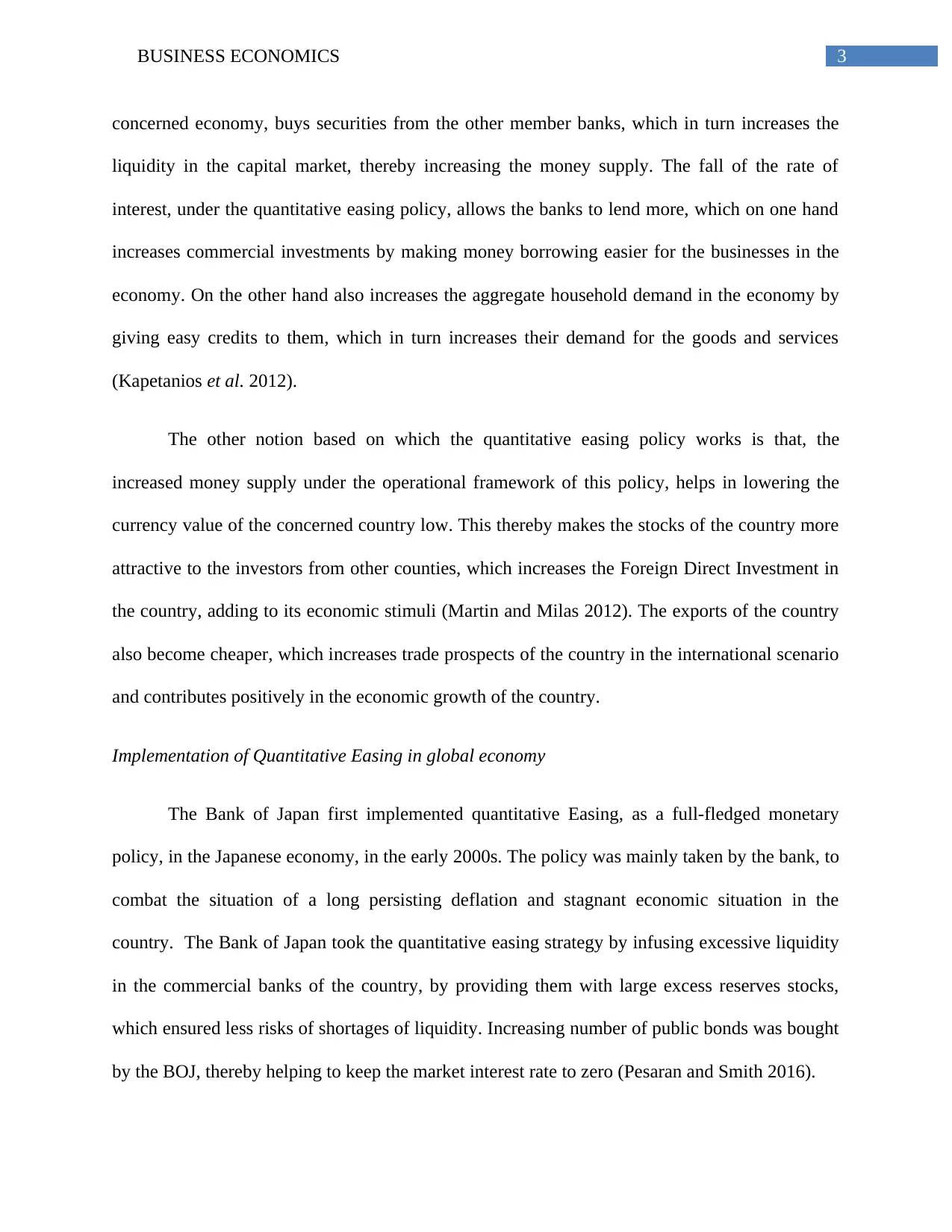
3BUSINESS ECONOMICS
concerned economy, buys securities from the other member banks, which in turn increases the
liquidity in the capital market, thereby increasing the money supply. The fall of the rate of
interest, under the quantitative easing policy, allows the banks to lend more, which on one hand
increases commercial investments by making money borrowing easier for the businesses in the
economy. On the other hand also increases the aggregate household demand in the economy by
giving easy credits to them, which in turn increases their demand for the goods and services
(Kapetanios et al. 2012).
The other notion based on which the quantitative easing policy works is that, the
increased money supply under the operational framework of this policy, helps in lowering the
currency value of the concerned country low. This thereby makes the stocks of the country more
attractive to the investors from other counties, which increases the Foreign Direct Investment in
the country, adding to its economic stimuli (Martin and Milas 2012). The exports of the country
also become cheaper, which increases trade prospects of the country in the international scenario
and contributes positively in the economic growth of the country.
Implementation of Quantitative Easing in global economy
The Bank of Japan first implemented quantitative Easing, as a full-fledged monetary
policy, in the Japanese economy, in the early 2000s. The policy was mainly taken by the bank, to
combat the situation of a long persisting deflation and stagnant economic situation in the
country. The Bank of Japan took the quantitative easing strategy by infusing excessive liquidity
in the commercial banks of the country, by providing them with large excess reserves stocks,
which ensured less risks of shortages of liquidity. Increasing number of public bonds was bought
by the BOJ, thereby helping to keep the market interest rate to zero (Pesaran and Smith 2016).
concerned economy, buys securities from the other member banks, which in turn increases the
liquidity in the capital market, thereby increasing the money supply. The fall of the rate of
interest, under the quantitative easing policy, allows the banks to lend more, which on one hand
increases commercial investments by making money borrowing easier for the businesses in the
economy. On the other hand also increases the aggregate household demand in the economy by
giving easy credits to them, which in turn increases their demand for the goods and services
(Kapetanios et al. 2012).
The other notion based on which the quantitative easing policy works is that, the
increased money supply under the operational framework of this policy, helps in lowering the
currency value of the concerned country low. This thereby makes the stocks of the country more
attractive to the investors from other counties, which increases the Foreign Direct Investment in
the country, adding to its economic stimuli (Martin and Milas 2012). The exports of the country
also become cheaper, which increases trade prospects of the country in the international scenario
and contributes positively in the economic growth of the country.
Implementation of Quantitative Easing in global economy
The Bank of Japan first implemented quantitative Easing, as a full-fledged monetary
policy, in the Japanese economy, in the early 2000s. The policy was mainly taken by the bank, to
combat the situation of a long persisting deflation and stagnant economic situation in the
country. The Bank of Japan took the quantitative easing strategy by infusing excessive liquidity
in the commercial banks of the country, by providing them with large excess reserves stocks,
which ensured less risks of shortages of liquidity. Increasing number of public bonds was bought
by the BOJ, thereby helping to keep the market interest rate to zero (Pesaran and Smith 2016).
Paraphrase This Document
Need a fresh take? Get an instant paraphrase of this document with our AI Paraphraser
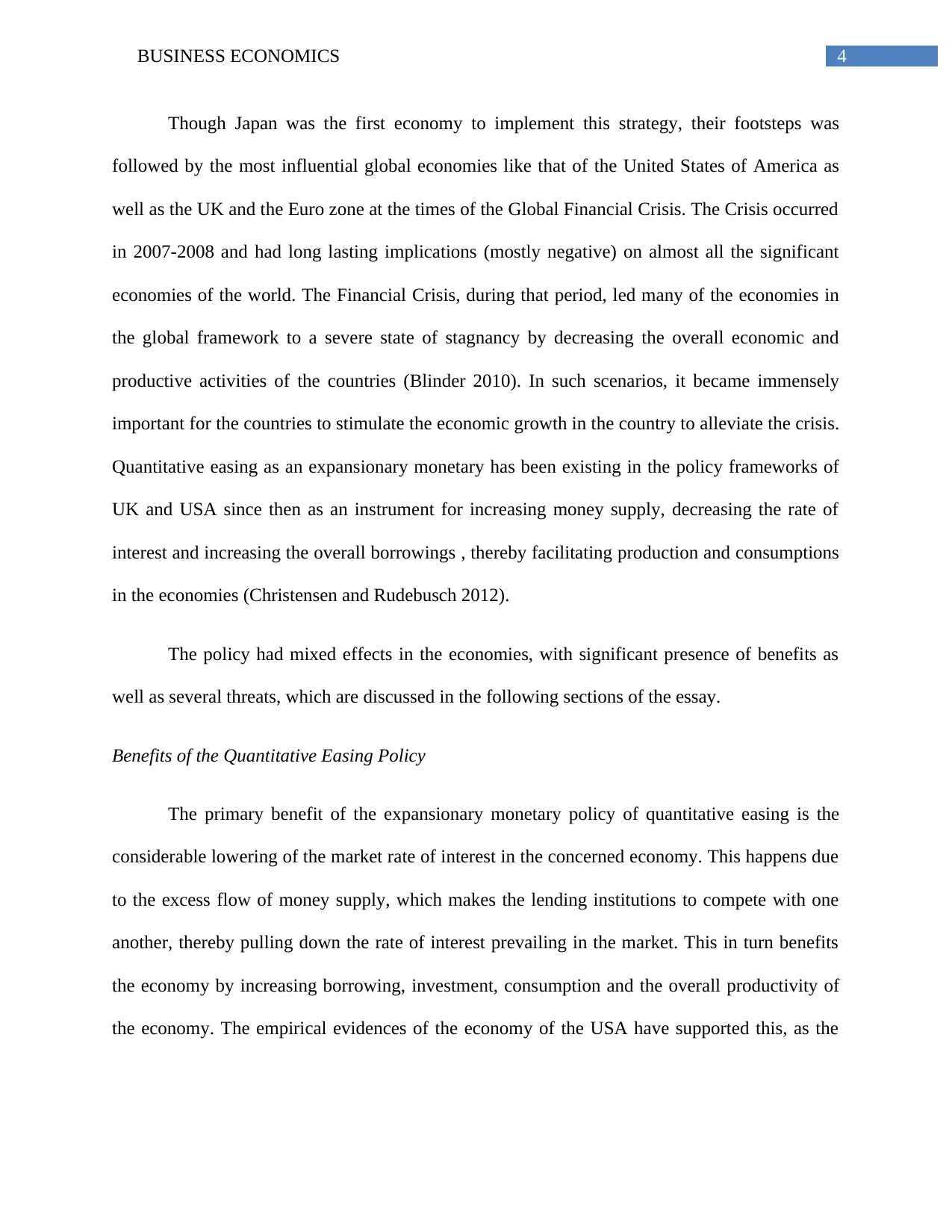
4BUSINESS ECONOMICS
Though Japan was the first economy to implement this strategy, their footsteps was
followed by the most influential global economies like that of the United States of America as
well as the UK and the Euro zone at the times of the Global Financial Crisis. The Crisis occurred
in 2007-2008 and had long lasting implications (mostly negative) on almost all the significant
economies of the world. The Financial Crisis, during that period, led many of the economies in
the global framework to a severe state of stagnancy by decreasing the overall economic and
productive activities of the countries (Blinder 2010). In such scenarios, it became immensely
important for the countries to stimulate the economic growth in the country to alleviate the crisis.
Quantitative easing as an expansionary monetary has been existing in the policy frameworks of
UK and USA since then as an instrument for increasing money supply, decreasing the rate of
interest and increasing the overall borrowings , thereby facilitating production and consumptions
in the economies (Christensen and Rudebusch 2012).
The policy had mixed effects in the economies, with significant presence of benefits as
well as several threats, which are discussed in the following sections of the essay.
Benefits of the Quantitative Easing Policy
The primary benefit of the expansionary monetary policy of quantitative easing is the
considerable lowering of the market rate of interest in the concerned economy. This happens due
to the excess flow of money supply, which makes the lending institutions to compete with one
another, thereby pulling down the rate of interest prevailing in the market. This in turn benefits
the economy by increasing borrowing, investment, consumption and the overall productivity of
the economy. The empirical evidences of the economy of the USA have supported this, as the
Though Japan was the first economy to implement this strategy, their footsteps was
followed by the most influential global economies like that of the United States of America as
well as the UK and the Euro zone at the times of the Global Financial Crisis. The Crisis occurred
in 2007-2008 and had long lasting implications (mostly negative) on almost all the significant
economies of the world. The Financial Crisis, during that period, led many of the economies in
the global framework to a severe state of stagnancy by decreasing the overall economic and
productive activities of the countries (Blinder 2010). In such scenarios, it became immensely
important for the countries to stimulate the economic growth in the country to alleviate the crisis.
Quantitative easing as an expansionary monetary has been existing in the policy frameworks of
UK and USA since then as an instrument for increasing money supply, decreasing the rate of
interest and increasing the overall borrowings , thereby facilitating production and consumptions
in the economies (Christensen and Rudebusch 2012).
The policy had mixed effects in the economies, with significant presence of benefits as
well as several threats, which are discussed in the following sections of the essay.
Benefits of the Quantitative Easing Policy
The primary benefit of the expansionary monetary policy of quantitative easing is the
considerable lowering of the market rate of interest in the concerned economy. This happens due
to the excess flow of money supply, which makes the lending institutions to compete with one
another, thereby pulling down the rate of interest prevailing in the market. This in turn benefits
the economy by increasing borrowing, investment, consumption and the overall productivity of
the economy. The empirical evidences of the economy of the USA have supported this, as the
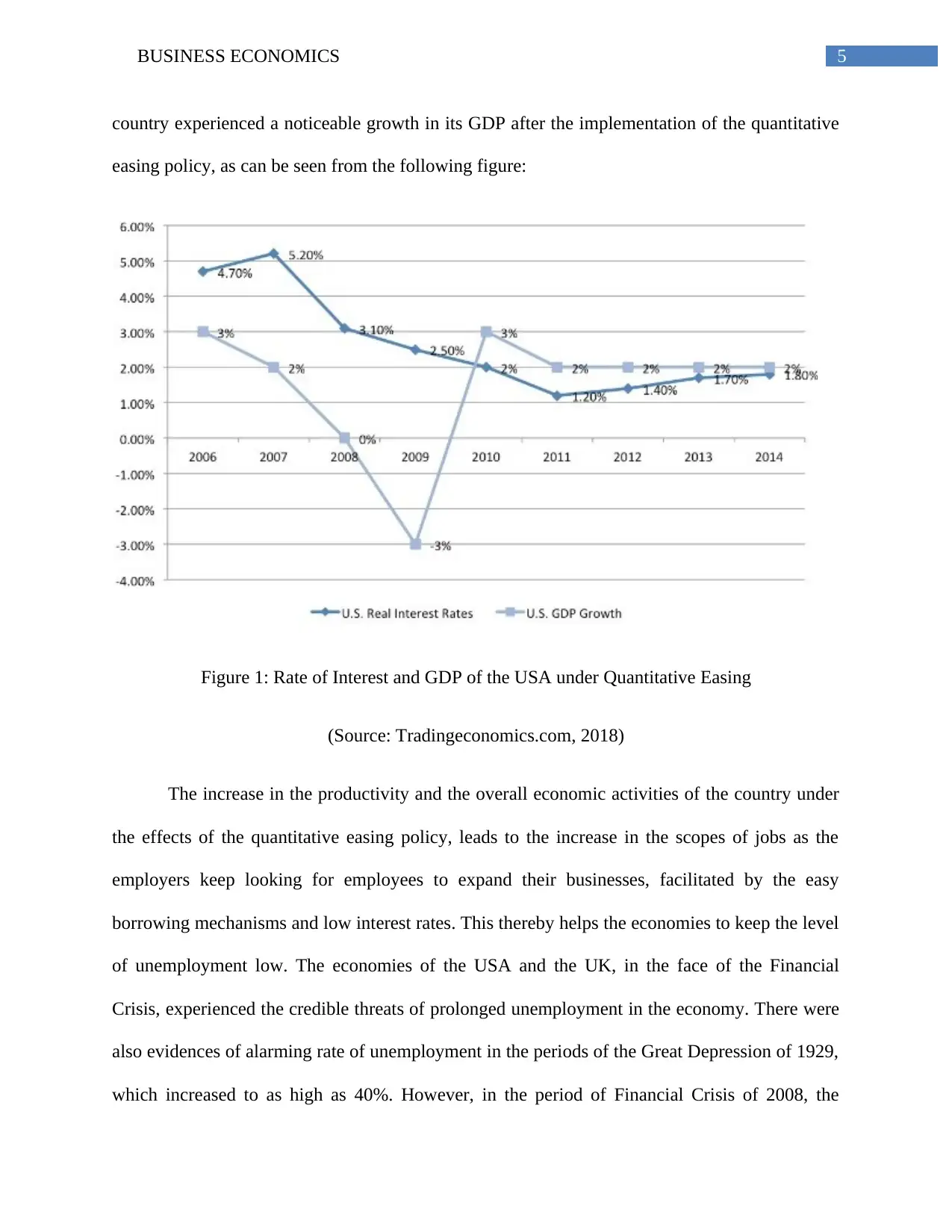
5BUSINESS ECONOMICS
country experienced a noticeable growth in its GDP after the implementation of the quantitative
easing policy, as can be seen from the following figure:
Figure 1: Rate of Interest and GDP of the USA under Quantitative Easing
(Source: Tradingeconomics.com, 2018)
The increase in the productivity and the overall economic activities of the country under
the effects of the quantitative easing policy, leads to the increase in the scopes of jobs as the
employers keep looking for employees to expand their businesses, facilitated by the easy
borrowing mechanisms and low interest rates. This thereby helps the economies to keep the level
of unemployment low. The economies of the USA and the UK, in the face of the Financial
Crisis, experienced the credible threats of prolonged unemployment in the economy. There were
also evidences of alarming rate of unemployment in the periods of the Great Depression of 1929,
which increased to as high as 40%. However, in the period of Financial Crisis of 2008, the
country experienced a noticeable growth in its GDP after the implementation of the quantitative
easing policy, as can be seen from the following figure:
Figure 1: Rate of Interest and GDP of the USA under Quantitative Easing
(Source: Tradingeconomics.com, 2018)
The increase in the productivity and the overall economic activities of the country under
the effects of the quantitative easing policy, leads to the increase in the scopes of jobs as the
employers keep looking for employees to expand their businesses, facilitated by the easy
borrowing mechanisms and low interest rates. This thereby helps the economies to keep the level
of unemployment low. The economies of the USA and the UK, in the face of the Financial
Crisis, experienced the credible threats of prolonged unemployment in the economy. There were
also evidences of alarming rate of unemployment in the periods of the Great Depression of 1929,
which increased to as high as 40%. However, in the period of Financial Crisis of 2008, the
⊘ This is a preview!⊘
Do you want full access?
Subscribe today to unlock all pages.

Trusted by 1+ million students worldwide
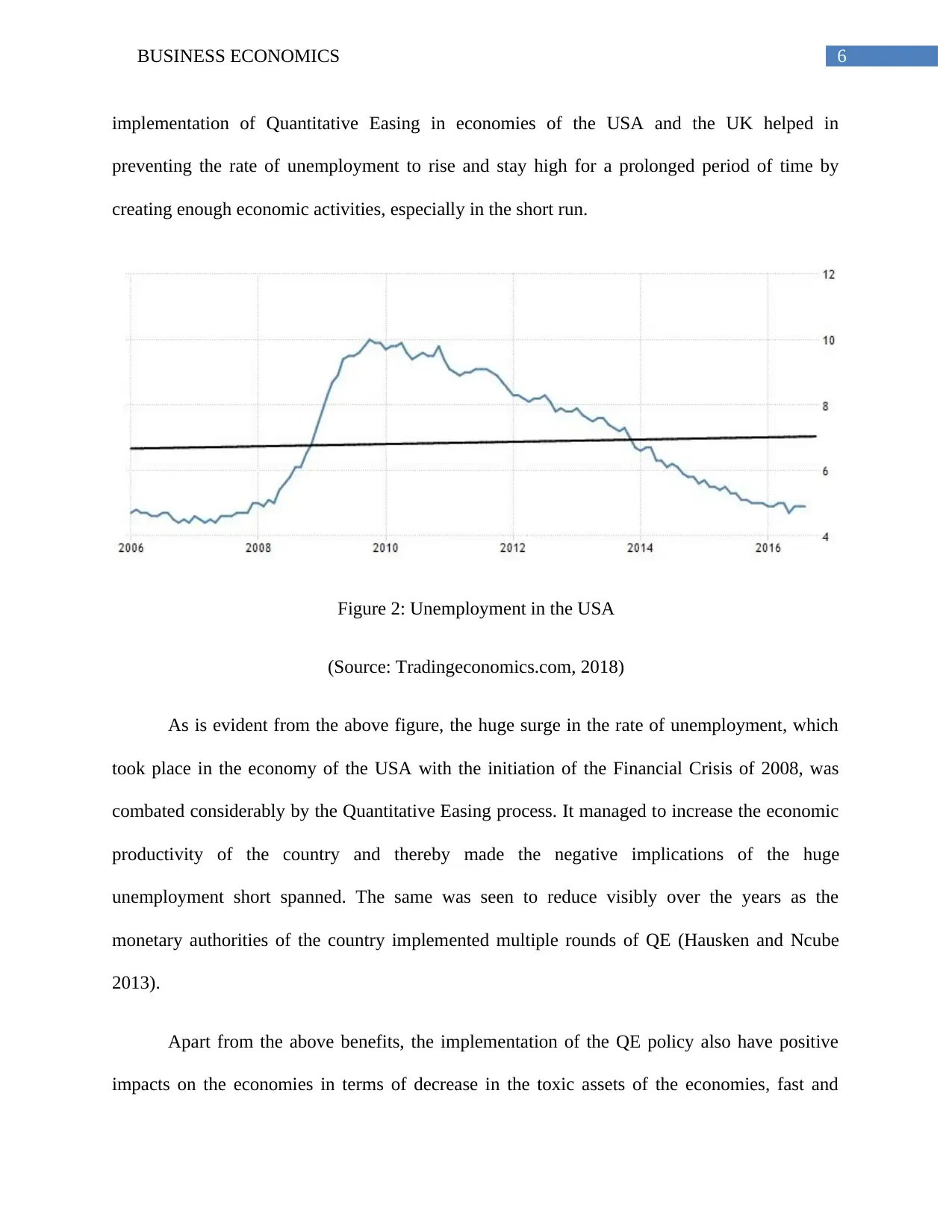
6BUSINESS ECONOMICS
implementation of Quantitative Easing in economies of the USA and the UK helped in
preventing the rate of unemployment to rise and stay high for a prolonged period of time by
creating enough economic activities, especially in the short run.
Figure 2: Unemployment in the USA
(Source: Tradingeconomics.com, 2018)
As is evident from the above figure, the huge surge in the rate of unemployment, which
took place in the economy of the USA with the initiation of the Financial Crisis of 2008, was
combated considerably by the Quantitative Easing process. It managed to increase the economic
productivity of the country and thereby made the negative implications of the huge
unemployment short spanned. The same was seen to reduce visibly over the years as the
monetary authorities of the country implemented multiple rounds of QE (Hausken and Ncube
2013).
Apart from the above benefits, the implementation of the QE policy also have positive
impacts on the economies in terms of decrease in the toxic assets of the economies, fast and
implementation of Quantitative Easing in economies of the USA and the UK helped in
preventing the rate of unemployment to rise and stay high for a prolonged period of time by
creating enough economic activities, especially in the short run.
Figure 2: Unemployment in the USA
(Source: Tradingeconomics.com, 2018)
As is evident from the above figure, the huge surge in the rate of unemployment, which
took place in the economy of the USA with the initiation of the Financial Crisis of 2008, was
combated considerably by the Quantitative Easing process. It managed to increase the economic
productivity of the country and thereby made the negative implications of the huge
unemployment short spanned. The same was seen to reduce visibly over the years as the
monetary authorities of the country implemented multiple rounds of QE (Hausken and Ncube
2013).
Apart from the above benefits, the implementation of the QE policy also have positive
impacts on the economies in terms of decrease in the toxic assets of the economies, fast and
Paraphrase This Document
Need a fresh take? Get an instant paraphrase of this document with our AI Paraphraser
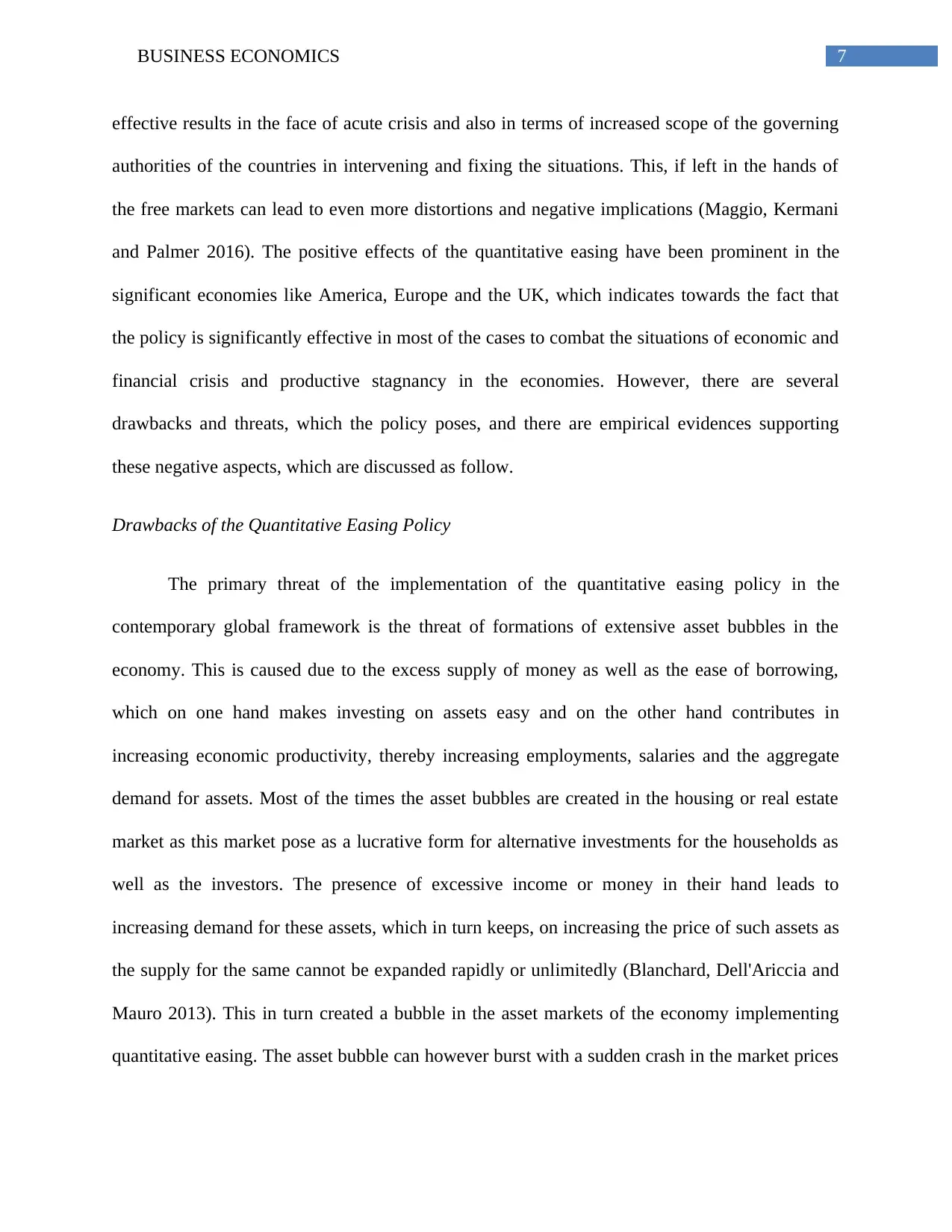
7BUSINESS ECONOMICS
effective results in the face of acute crisis and also in terms of increased scope of the governing
authorities of the countries in intervening and fixing the situations. This, if left in the hands of
the free markets can lead to even more distortions and negative implications (Maggio, Kermani
and Palmer 2016). The positive effects of the quantitative easing have been prominent in the
significant economies like America, Europe and the UK, which indicates towards the fact that
the policy is significantly effective in most of the cases to combat the situations of economic and
financial crisis and productive stagnancy in the economies. However, there are several
drawbacks and threats, which the policy poses, and there are empirical evidences supporting
these negative aspects, which are discussed as follow.
Drawbacks of the Quantitative Easing Policy
The primary threat of the implementation of the quantitative easing policy in the
contemporary global framework is the threat of formations of extensive asset bubbles in the
economy. This is caused due to the excess supply of money as well as the ease of borrowing,
which on one hand makes investing on assets easy and on the other hand contributes in
increasing economic productivity, thereby increasing employments, salaries and the aggregate
demand for assets. Most of the times the asset bubbles are created in the housing or real estate
market as this market pose as a lucrative form for alternative investments for the households as
well as the investors. The presence of excessive income or money in their hand leads to
increasing demand for these assets, which in turn keeps, on increasing the price of such assets as
the supply for the same cannot be expanded rapidly or unlimitedly (Blanchard, Dell'Ariccia and
Mauro 2013). This in turn created a bubble in the asset markets of the economy implementing
quantitative easing. The asset bubble can however burst with a sudden crash in the market prices
effective results in the face of acute crisis and also in terms of increased scope of the governing
authorities of the countries in intervening and fixing the situations. This, if left in the hands of
the free markets can lead to even more distortions and negative implications (Maggio, Kermani
and Palmer 2016). The positive effects of the quantitative easing have been prominent in the
significant economies like America, Europe and the UK, which indicates towards the fact that
the policy is significantly effective in most of the cases to combat the situations of economic and
financial crisis and productive stagnancy in the economies. However, there are several
drawbacks and threats, which the policy poses, and there are empirical evidences supporting
these negative aspects, which are discussed as follow.
Drawbacks of the Quantitative Easing Policy
The primary threat of the implementation of the quantitative easing policy in the
contemporary global framework is the threat of formations of extensive asset bubbles in the
economy. This is caused due to the excess supply of money as well as the ease of borrowing,
which on one hand makes investing on assets easy and on the other hand contributes in
increasing economic productivity, thereby increasing employments, salaries and the aggregate
demand for assets. Most of the times the asset bubbles are created in the housing or real estate
market as this market pose as a lucrative form for alternative investments for the households as
well as the investors. The presence of excessive income or money in their hand leads to
increasing demand for these assets, which in turn keeps, on increasing the price of such assets as
the supply for the same cannot be expanded rapidly or unlimitedly (Blanchard, Dell'Ariccia and
Mauro 2013). This in turn created a bubble in the asset markets of the economy implementing
quantitative easing. The asset bubble can however burst with a sudden crash in the market prices
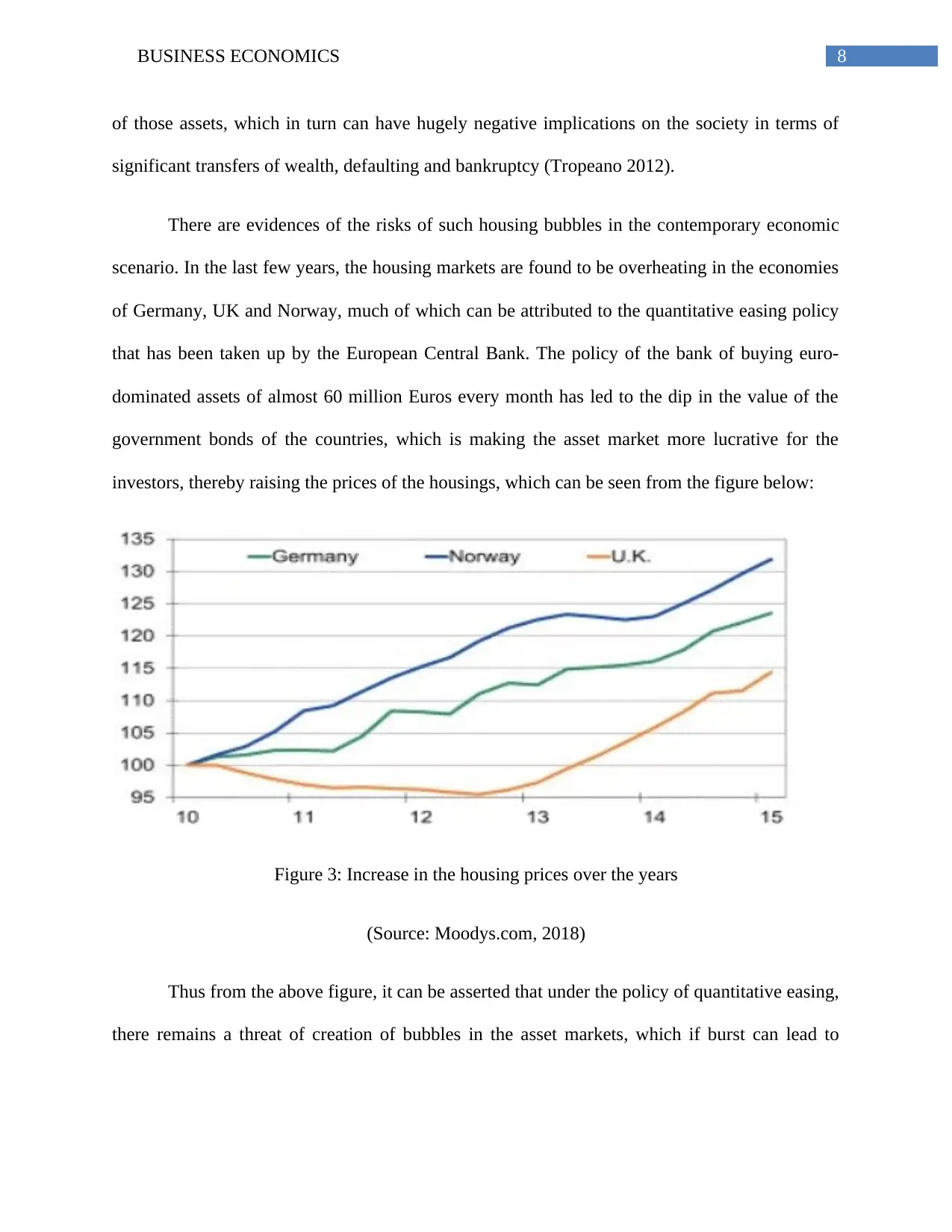
8BUSINESS ECONOMICS
of those assets, which in turn can have hugely negative implications on the society in terms of
significant transfers of wealth, defaulting and bankruptcy (Tropeano 2012).
There are evidences of the risks of such housing bubbles in the contemporary economic
scenario. In the last few years, the housing markets are found to be overheating in the economies
of Germany, UK and Norway, much of which can be attributed to the quantitative easing policy
that has been taken up by the European Central Bank. The policy of the bank of buying euro-
dominated assets of almost 60 million Euros every month has led to the dip in the value of the
government bonds of the countries, which is making the asset market more lucrative for the
investors, thereby raising the prices of the housings, which can be seen from the figure below:
Figure 3: Increase in the housing prices over the years
(Source: Moodys.com, 2018)
Thus from the above figure, it can be asserted that under the policy of quantitative easing,
there remains a threat of creation of bubbles in the asset markets, which if burst can lead to
of those assets, which in turn can have hugely negative implications on the society in terms of
significant transfers of wealth, defaulting and bankruptcy (Tropeano 2012).
There are evidences of the risks of such housing bubbles in the contemporary economic
scenario. In the last few years, the housing markets are found to be overheating in the economies
of Germany, UK and Norway, much of which can be attributed to the quantitative easing policy
that has been taken up by the European Central Bank. The policy of the bank of buying euro-
dominated assets of almost 60 million Euros every month has led to the dip in the value of the
government bonds of the countries, which is making the asset market more lucrative for the
investors, thereby raising the prices of the housings, which can be seen from the figure below:
Figure 3: Increase in the housing prices over the years
(Source: Moodys.com, 2018)
Thus from the above figure, it can be asserted that under the policy of quantitative easing,
there remains a threat of creation of bubbles in the asset markets, which if burst can lead to
⊘ This is a preview!⊘
Do you want full access?
Subscribe today to unlock all pages.

Trusted by 1+ million students worldwide
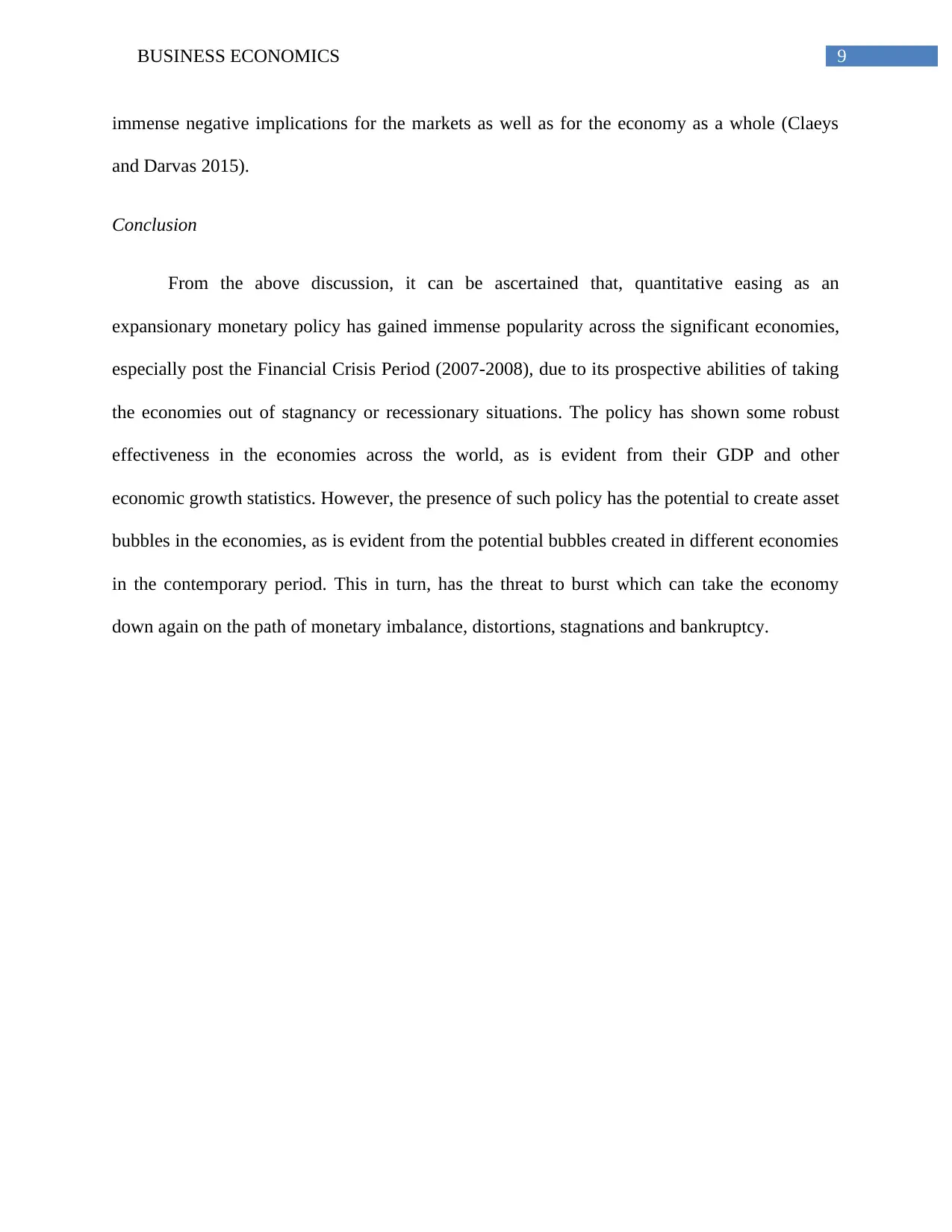
9BUSINESS ECONOMICS
immense negative implications for the markets as well as for the economy as a whole (Claeys
and Darvas 2015).
Conclusion
From the above discussion, it can be ascertained that, quantitative easing as an
expansionary monetary policy has gained immense popularity across the significant economies,
especially post the Financial Crisis Period (2007-2008), due to its prospective abilities of taking
the economies out of stagnancy or recessionary situations. The policy has shown some robust
effectiveness in the economies across the world, as is evident from their GDP and other
economic growth statistics. However, the presence of such policy has the potential to create asset
bubbles in the economies, as is evident from the potential bubbles created in different economies
in the contemporary period. This in turn, has the threat to burst which can take the economy
down again on the path of monetary imbalance, distortions, stagnations and bankruptcy.
immense negative implications for the markets as well as for the economy as a whole (Claeys
and Darvas 2015).
Conclusion
From the above discussion, it can be ascertained that, quantitative easing as an
expansionary monetary policy has gained immense popularity across the significant economies,
especially post the Financial Crisis Period (2007-2008), due to its prospective abilities of taking
the economies out of stagnancy or recessionary situations. The policy has shown some robust
effectiveness in the economies across the world, as is evident from their GDP and other
economic growth statistics. However, the presence of such policy has the potential to create asset
bubbles in the economies, as is evident from the potential bubbles created in different economies
in the contemporary period. This in turn, has the threat to burst which can take the economy
down again on the path of monetary imbalance, distortions, stagnations and bankruptcy.
Paraphrase This Document
Need a fresh take? Get an instant paraphrase of this document with our AI Paraphraser
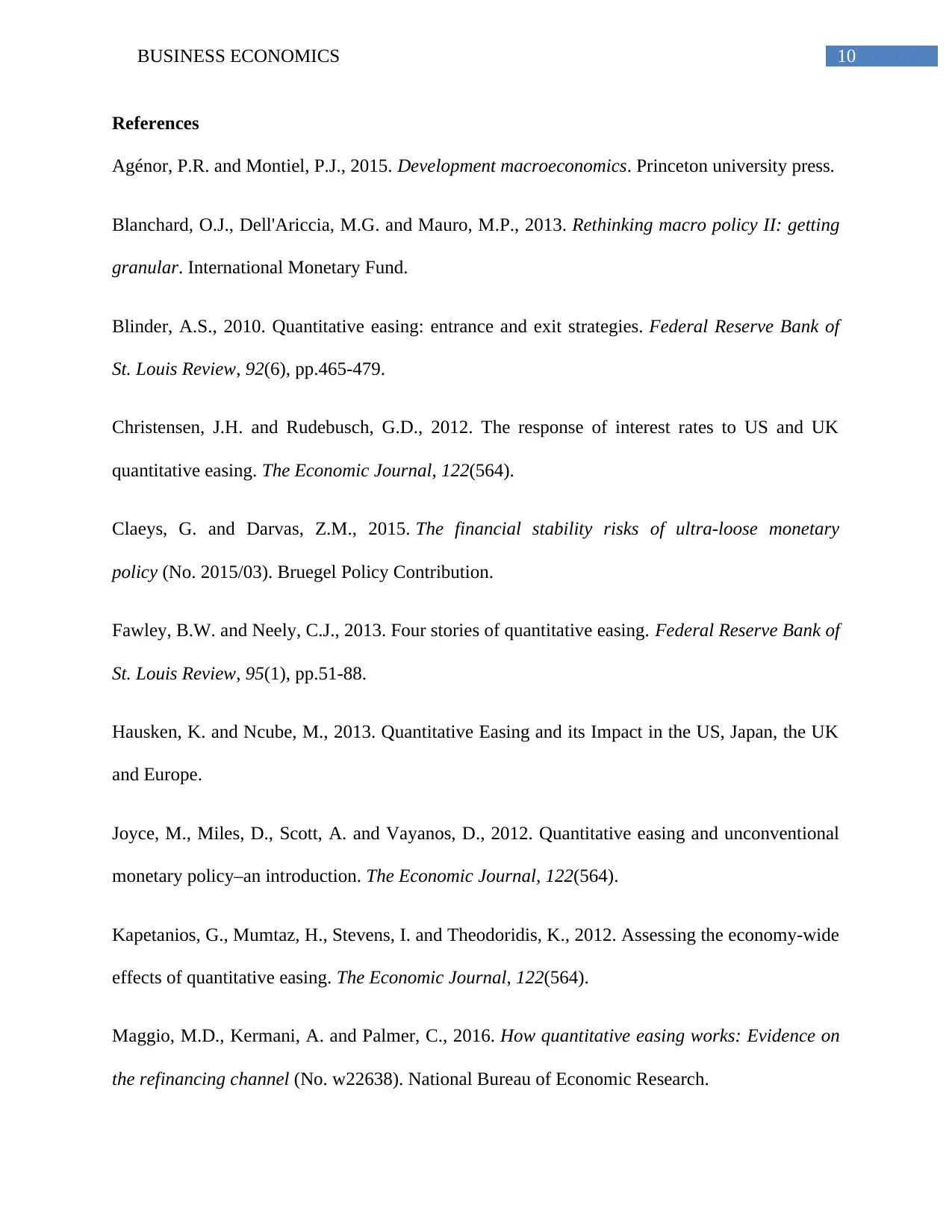
10BUSINESS ECONOMICS
References
Agénor, P.R. and Montiel, P.J., 2015. Development macroeconomics. Princeton university press.
Blanchard, O.J., Dell'Ariccia, M.G. and Mauro, M.P., 2013. Rethinking macro policy II: getting
granular. International Monetary Fund.
Blinder, A.S., 2010. Quantitative easing: entrance and exit strategies. Federal Reserve Bank of
St. Louis Review, 92(6), pp.465-479.
Christensen, J.H. and Rudebusch, G.D., 2012. The response of interest rates to US and UK
quantitative easing. The Economic Journal, 122(564).
Claeys, G. and Darvas, Z.M., 2015. The financial stability risks of ultra-loose monetary
policy (No. 2015/03). Bruegel Policy Contribution.
Fawley, B.W. and Neely, C.J., 2013. Four stories of quantitative easing. Federal Reserve Bank of
St. Louis Review, 95(1), pp.51-88.
Hausken, K. and Ncube, M., 2013. Quantitative Easing and its Impact in the US, Japan, the UK
and Europe.
Joyce, M., Miles, D., Scott, A. and Vayanos, D., 2012. Quantitative easing and unconventional
monetary policy–an introduction. The Economic Journal, 122(564).
Kapetanios, G., Mumtaz, H., Stevens, I. and Theodoridis, K., 2012. Assessing the economy‐wide
effects of quantitative easing. The Economic Journal, 122(564).
Maggio, M.D., Kermani, A. and Palmer, C., 2016. How quantitative easing works: Evidence on
the refinancing channel (No. w22638). National Bureau of Economic Research.
References
Agénor, P.R. and Montiel, P.J., 2015. Development macroeconomics. Princeton university press.
Blanchard, O.J., Dell'Ariccia, M.G. and Mauro, M.P., 2013. Rethinking macro policy II: getting
granular. International Monetary Fund.
Blinder, A.S., 2010. Quantitative easing: entrance and exit strategies. Federal Reserve Bank of
St. Louis Review, 92(6), pp.465-479.
Christensen, J.H. and Rudebusch, G.D., 2012. The response of interest rates to US and UK
quantitative easing. The Economic Journal, 122(564).
Claeys, G. and Darvas, Z.M., 2015. The financial stability risks of ultra-loose monetary
policy (No. 2015/03). Bruegel Policy Contribution.
Fawley, B.W. and Neely, C.J., 2013. Four stories of quantitative easing. Federal Reserve Bank of
St. Louis Review, 95(1), pp.51-88.
Hausken, K. and Ncube, M., 2013. Quantitative Easing and its Impact in the US, Japan, the UK
and Europe.
Joyce, M., Miles, D., Scott, A. and Vayanos, D., 2012. Quantitative easing and unconventional
monetary policy–an introduction. The Economic Journal, 122(564).
Kapetanios, G., Mumtaz, H., Stevens, I. and Theodoridis, K., 2012. Assessing the economy‐wide
effects of quantitative easing. The Economic Journal, 122(564).
Maggio, M.D., Kermani, A. and Palmer, C., 2016. How quantitative easing works: Evidence on
the refinancing channel (No. w22638). National Bureau of Economic Research.
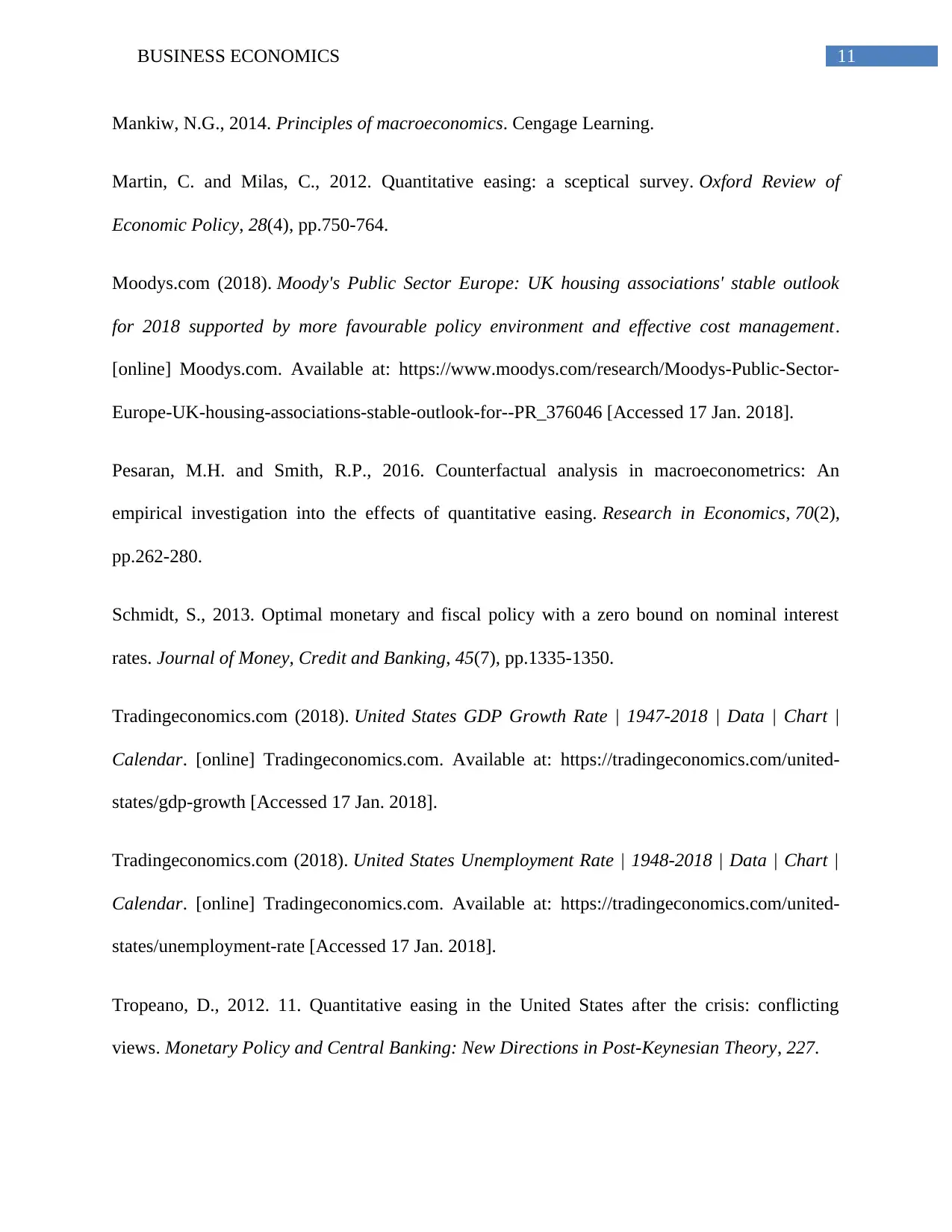
11BUSINESS ECONOMICS
Mankiw, N.G., 2014. Principles of macroeconomics. Cengage Learning.
Martin, C. and Milas, C., 2012. Quantitative easing: a sceptical survey. Oxford Review of
Economic Policy, 28(4), pp.750-764.
Moodys.com (2018). Moody's Public Sector Europe: UK housing associations' stable outlook
for 2018 supported by more favourable policy environment and effective cost management.
[online] Moodys.com. Available at: https://www.moodys.com/research/Moodys-Public-Sector-
Europe-UK-housing-associations-stable-outlook-for--PR_376046 [Accessed 17 Jan. 2018].
Pesaran, M.H. and Smith, R.P., 2016. Counterfactual analysis in macroeconometrics: An
empirical investigation into the effects of quantitative easing. Research in Economics, 70(2),
pp.262-280.
Schmidt, S., 2013. Optimal monetary and fiscal policy with a zero bound on nominal interest
rates. Journal of Money, Credit and Banking, 45(7), pp.1335-1350.
Tradingeconomics.com (2018). United States GDP Growth Rate | 1947-2018 | Data | Chart |
Calendar. [online] Tradingeconomics.com. Available at: https://tradingeconomics.com/united-
states/gdp-growth [Accessed 17 Jan. 2018].
Tradingeconomics.com (2018). United States Unemployment Rate | 1948-2018 | Data | Chart |
Calendar. [online] Tradingeconomics.com. Available at: https://tradingeconomics.com/united-
states/unemployment-rate [Accessed 17 Jan. 2018].
Tropeano, D., 2012. 11. Quantitative easing in the United States after the crisis: conflicting
views. Monetary Policy and Central Banking: New Directions in Post-Keynesian Theory, 227.
Mankiw, N.G., 2014. Principles of macroeconomics. Cengage Learning.
Martin, C. and Milas, C., 2012. Quantitative easing: a sceptical survey. Oxford Review of
Economic Policy, 28(4), pp.750-764.
Moodys.com (2018). Moody's Public Sector Europe: UK housing associations' stable outlook
for 2018 supported by more favourable policy environment and effective cost management.
[online] Moodys.com. Available at: https://www.moodys.com/research/Moodys-Public-Sector-
Europe-UK-housing-associations-stable-outlook-for--PR_376046 [Accessed 17 Jan. 2018].
Pesaran, M.H. and Smith, R.P., 2016. Counterfactual analysis in macroeconometrics: An
empirical investigation into the effects of quantitative easing. Research in Economics, 70(2),
pp.262-280.
Schmidt, S., 2013. Optimal monetary and fiscal policy with a zero bound on nominal interest
rates. Journal of Money, Credit and Banking, 45(7), pp.1335-1350.
Tradingeconomics.com (2018). United States GDP Growth Rate | 1947-2018 | Data | Chart |
Calendar. [online] Tradingeconomics.com. Available at: https://tradingeconomics.com/united-
states/gdp-growth [Accessed 17 Jan. 2018].
Tradingeconomics.com (2018). United States Unemployment Rate | 1948-2018 | Data | Chart |
Calendar. [online] Tradingeconomics.com. Available at: https://tradingeconomics.com/united-
states/unemployment-rate [Accessed 17 Jan. 2018].
Tropeano, D., 2012. 11. Quantitative easing in the United States after the crisis: conflicting
views. Monetary Policy and Central Banking: New Directions in Post-Keynesian Theory, 227.
⊘ This is a preview!⊘
Do you want full access?
Subscribe today to unlock all pages.

Trusted by 1+ million students worldwide
1 out of 12
Related Documents
Your All-in-One AI-Powered Toolkit for Academic Success.
+13062052269
info@desklib.com
Available 24*7 on WhatsApp / Email
![[object Object]](/_next/static/media/star-bottom.7253800d.svg)
Unlock your academic potential
Copyright © 2020–2025 A2Z Services. All Rights Reserved. Developed and managed by ZUCOL.





